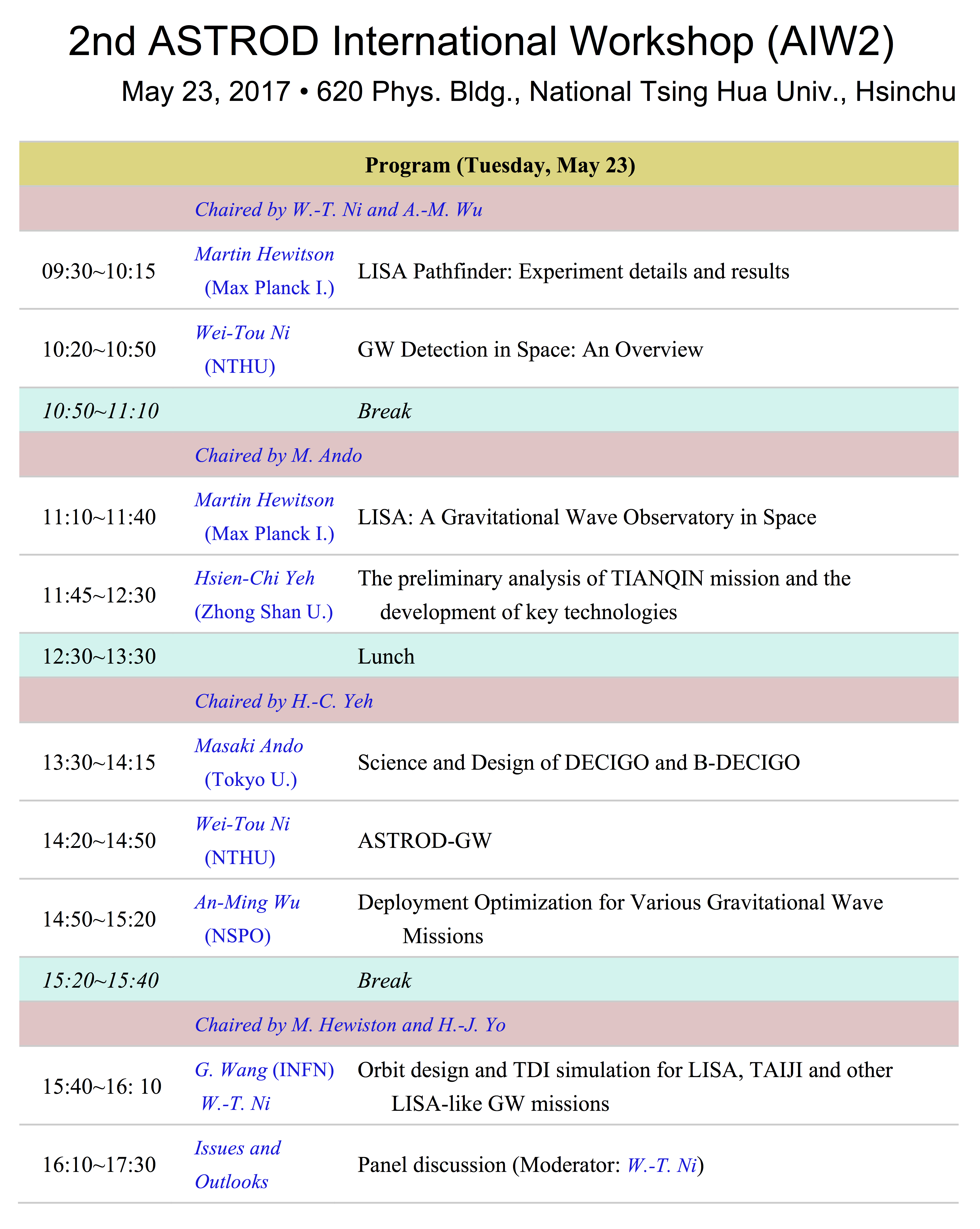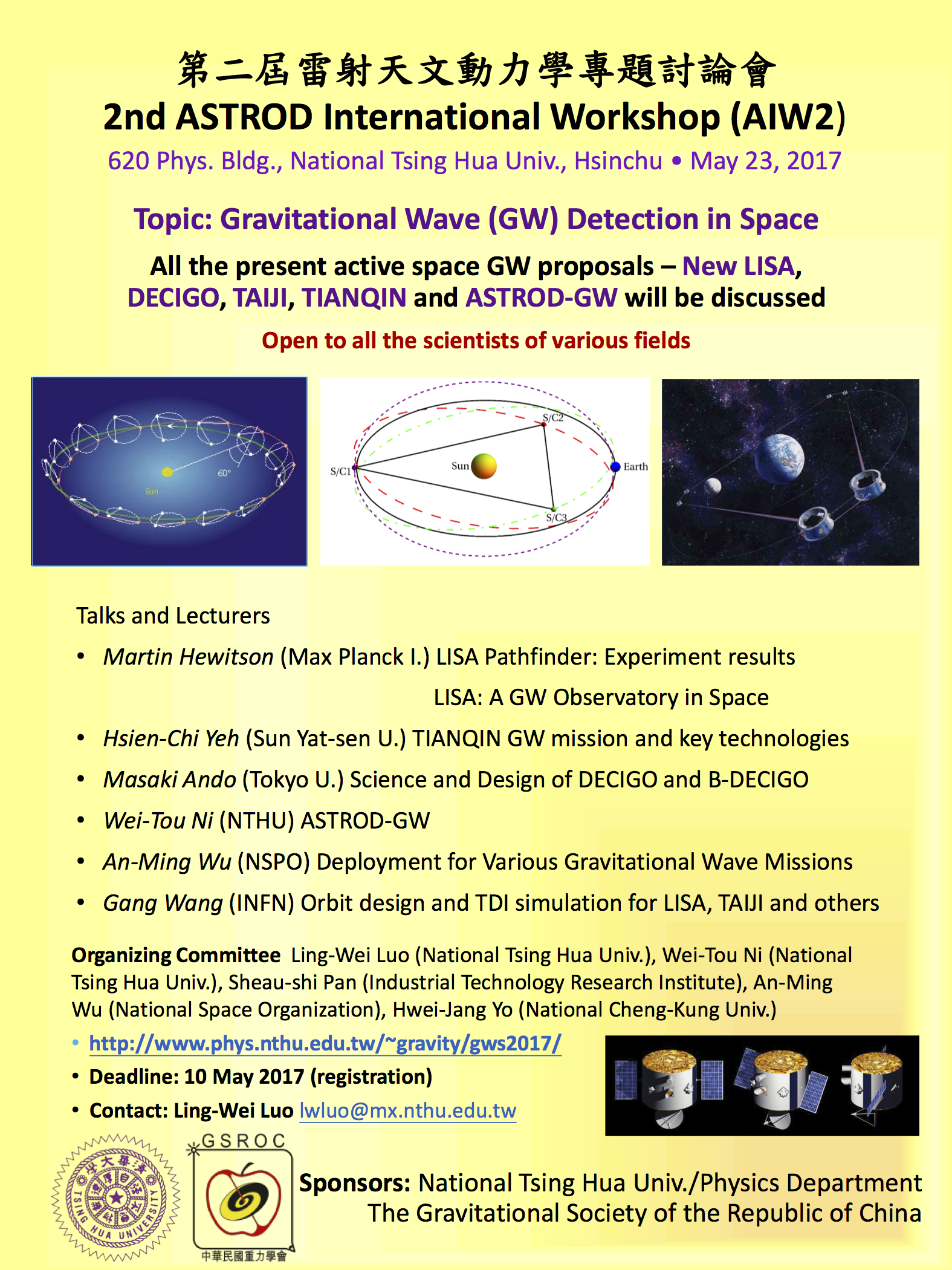The 2nd ASTROD International Workshop on
Laser Astrodynamics, Space Test of Relativity
and Gravitational-Wave Astronomy
2nd ASTROD International Workshop (AIW2)
May 23, 2017 • 620 Phys. Bldg., National Tsing Hua Univ., Hsinchu, Taiwan
Program
- Date: May 23, 2017
- Place: Lecture Room 620, Physics Building, NTHU
- Program Download: May 23 Program

Abstracts and Slides
- Files Download: Abstracts for AIW2
LISA Pathfinder: experiment details and results
Martin Hewitson on behalf of the LPF Collaboration
(PDF)
Abstract
On December 3rd 2015 at 04:04 UTC, the European Space Agency launched
the LISA Pathfinder satellite on board a VEGA rocket from Kourou
in French Guiana. After a series of orbit raising manoeuvres and
a 2 month long transfer orbit, LISA Pathfinder arrived at L1.
Following a period of commissioning, the science operations commenced
on March 1st, beginning the demonstration of technologies and
methodologies. This phase was followed by a 3 month period of
operations of the NASA payload items. Since then,
the mission has been in its extension phase,
and will continue to operate until the end of June 2017.
The results from LPF pave the way for a future large-scale
gravitational wave observatory in space. This talk will
describe the LISA Pathfinder mission in detail, looking
at many aspects of the experiments that have been performed,
all of which lead to the exceptional performance.
The results from the main mission period will be discussed in detail,
and contrast against the improved results gained in the mission extension.
GW Detection in Space: An Overview
Wei-Tou Ni
(PDF)
Abstract
Gravitational wave (GW) detection in space is aimed at low frequency band
(100 nHz – 100 mHz) and middle frequency band (100 mHz – 10 Hz).
The science goals are the detection of GWs from (i) Supermassive Black Holes;
(ii) Extreme-Mass-Ratio Black Hole Inspirals; (iii) Intermediate-Mass Black Holes;
(iv) Galactic Compact Binaries and (v) Relic GW Background.
In this paper, we present an overview on the sensitivity, orbit design,
basic orbit configuration, angular resolution, orbit optimization, deployment,
time-delay interferometry and payload concept of the current proposed GW detectors
in space under study. The detector proposals under study have arm length ranging
from 1000 km to 1.3 × 109 km (8.6 AU) including
(a) Solar orbiting detectors -- ASTROD-GW (ASTROD [Astrodynamical Space Test of
Relativity using Optical Devices] optimized for GW detection),
BBO (Big Bang Observer), DECIGO (DECi-hertz Interferometer GW Observatory),
e-LISA (evolved LISA [Laser Interferometer Space Antenna]), LISA,
other LISA-type detectors such as ALIA, TAIJI etc. (in Earth-like solar orbits),
and Super-ASTROD (in Jupiter-like solar orbits); and
(b) Earth orbiting detectors -- ASTROD-EM/LAGRANGE, GADFLI/GEOGRAWI/g-LISA,
OMEGA and TIANQIN.
LISA: A Gravitational Wave Observatory in Space
Martin Hewitson on behalf of the LISA Consortium
(PDF)
Abstract
The Laser Interferometer Space Antenna (LISA) is a gravitational wave observatory
in space, targeting the millihertz frequency band where a large number of
astrophysical and cosmological sources of gravitational waves is expected.
In 2013, the European Space Agency selected the science theme
"The Gravitational Universe", which focuses on this rich science.
In 2016, a call was issued by ESA for missions to address this science,
and the LISA Consortium responded to that call with the LISA mission.
This talk will review the LISA mission as a whole, highlight the outstanding
science that it will deliver. We will also look at the technical aspects of
the design, as well as the strong heritage from the LISA Pathfinder mission,
all of which leads to an expected performance able to deliver the science of
"The Gravitational Universe".
The preliminary analysis of TIANQIN mission and the development of key technologies
Hsien-Chi Yeh
(PPTX)
Science and Design of DECIGO and B-DECIGO
Masaki Ando
(PDF)
ASTROD-GW
Wei-Tou Ni
(PDF)
Abstract
We present an overview of Astrodynamical Space Test of Relativity using
Optical Devices (ASTROD-GW) optimized for Gravitational Wave (GW) detection mission
concept and its studies. ASTROD-GW is an optimization of ASTROD which focuses on
low frequency GW detection. The detection sensitivity is shifted by a factor of
260 (52) towards longer wavelengths compared with that of the new LISA.
The mission consists of three spacecraft, each of which orbits near one of
the Sun–Earth Lagrange points (L3, L4 and L5), such that the array forms an
almost equilateral triangle. The three spacecraft range interferometrically
with one another with an arm length of about 260 million kilometers.
The orbits have been optimized resulting in arm length changes of less than
±0.00015 AU or, fractionally, less than ±10−4 in 20 years,
and relative Doppler velocities of the three spacecraft of less than ±3m/s.
In this paper, we present an overview of the mission covering: the scientific aims,
the sensitivity spectrum, the basic orbit configuration,
the simulation and optimization of the spacecraft orbits,
the deployment of ASTROD-GW formation, Time Delay Interferometry (TDI) and the payload.
The science goals are the detection of GWs from (i) Supermassive Black Holes;
(ii) Extreme-Mass-Ratio Black Hole Inspirals; (iii) Intermediate-Mass Black Holes;
(iv) Galactic Compact Binaries and (v) Relic GW Background. For the purposes of
primordial GW detection, a six spacecraft formation would be needed to enable
the correlated detection of stochastic GWs. A brief discussion of the
six spacecraft orbit optimization is also presented.
Deployment Optimization for Various Gravitational Wave Missions
An-Ming Wu
(PPT)
Abstract
Space Gravitational Wave (GW) mission proposals often use constellation or
formation flying for the required interferometry implementation.
The spacecraft of most of these mission proposals go to deep space and
many have Earthlike orbits around the Sun. ASTROD-GW, Big Bang Observer and
DECIGO have spacecraft distributed in Earthlike orbits in formation.
LISA has three spacecraft arranged in a nearly equilateral triangle
formation with 2.5 Mkm arms, inclined by 60˚ with respect to the ecliptic and
flying along an Earth-like heliocentric orbit trailing Earth by 20˚.
ALIA-Descope (Taiji) are proposed to work on time delay interferometry
for 3, 4, 6 Mkm arm-length LISA-like orbits. ASTROD-GW has 3 spacecraft
near Lagrange points to range interferometrically with one another with
arm length about 260 Mkm. Since the deployment is related to
the spacecraft mass and travel time, it is critical for the mission cost.
LISA is proposed to be launched on 2030.12.18 with transfer time of 400 day
to arrive mission orbits. After specifying the initial states of
three spacecraft on mission orbits according to JPL DE431 solar ephemerides,
we use the multi-segment compact finite-difference method for the orbit equation
to calculate the delta-V for deployment of LISA from LEO. The deployment of
3 spacecraft to 3 mission orbits has slight different delta-V for each.
Furthermore, the deployment is optimized for delta-V with the launch date and
the transfer time for LISA and LISA-like missions.
Orbit design and TDI simulation for LISA, TAIJI and other LISA-like GW missions
Gang Wang and Wei-Tou Ni
(PDF)
Abstract
In order to attain the requisite sensitivity, laser frequency noise must be
suppressed to below the secondary noises such as the optical path noise,
acceleration noise etc. In early investigations, we have performed
the numerical simulation of the time delay interferometry (TDI) for original LISA,
ASTROD-GW and eLISA together with a LISA-type mission with a nominal arm length
of 2 × 106 km using the CGC 2.7.1 ephemeris framework.
In this talk, we follow the same procedure to simulate the time delay interferometry
numerically for the new LISA mission and the TAIJI mission together with
LISA-like missions of arm length 1 × 106 km, 2 × 106 km,
4 × 106 km, 5 × 106 km and 6 × 106 km.
To do this, we work out a set of 2200-day (6-year)
optimized mission orbits of each mission starting at March 22,2028
using the CGC 2.7.1 ephemeris framework. We then use numerical method to
calculate the residual optical path differences of first-generation TDI
configurations --- Michelson X, Y & Z; Sagnac α, β & γ; Relay U, V & W;
Beacon P, Q & R; Monitor E, F & G --- and the second generation
TDI configurations --- 2 arm type [ab, ba]'s; [aabb, bbaa]'s; [abab, baba]'s;
[abba, baab]'s; Sagnac-type α12-1, α12-2 & α12-3.
We compile and compare the resulting differences of various TDI configurations
due to the different arm lengths for various LISA-like mission proposals and
for the ASTROD-GW mission proposal.
